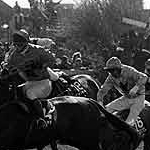 Few will need reminding that Captain Becher’s tumble into the ditch on the landing side of what is now the sixth fence in the Grand National is the origin of the most famous steeplechase obstacle anywhere.
Few will need reminding that Captain Becher’s tumble into the ditch on the landing side of what is now the sixth fence in the Grand National is the origin of the most famous steeplechase obstacle anywhere.
That was when riding Conrad in the 1839 National, and the story goes that after the race he related how he spat out the water he’d accidentally imbibed and how vile it tasted without whisky. It is strange how he is remembered for falling at a place where hundreds of others
fell, rather than for being the first man to ride a winner over hurdles at and over fences at Aintree. That was on The Duke in the Grand National of 1836, the year that John Pinfold asserts was truly its first running, not 1839 as was originally believed.
What is also forgotten is that he remounted quickly and caught up the rest of the field at the Canal Turn, only for Conrad to give him a much worse fall at Valentine’s, where their race ended.
Martin Becher (1797-1864) was the son of a Norfolk farmer and horse dealer. Thanks to being commissioned in the Yeomanry he was entitled to call himself Captain Becher. He began riding in races since 1823, if not earlier, and quickly became one of the leading jockeys of his generation, winning all the major steeplechases in the 1830s as that new sport took off. He actually rode more on the flat than over jumps.
There is an unverified report of him winning 48 out of 54 races in 1834, an unbelievable strike rate – yet Aintree expert John Pinfold himself verified he won 17 out of 23 rides he could track down. Not all minor flat race meetings and steeplechases were recorded then.
This is taken from John Pinfold’s 2008 booklet Captain Becher, part of Paul Davies’s The Complete Record series of publications. It gives a full account of the life and career of the man.
A Becher Chase was introduced at Aintree in 1905, on the first day of a four-day mixed meeting in November. How times have changed! It ended in 1965, when financial pressures were starting to curtail the racing programme.
It was revived in 1992 at Aintree’s December meeting. By then the courses’s fortunes had been re-established so well that it could afford to introduce a couple of races over the National fences at two of its autumn fixtures. The Becher is run over 3m2f, starting near Valentine’s.